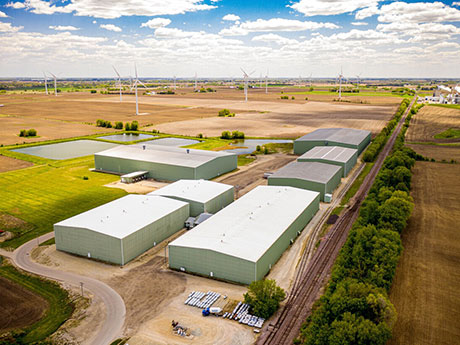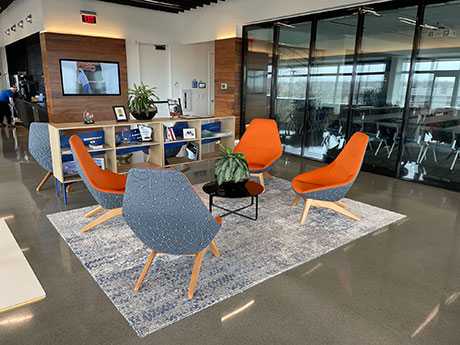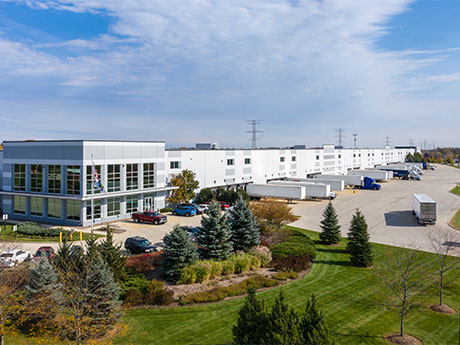By David Hodge, NAI Greywolf The demand for commercial industrial real estate was exceedingly strong in the Milwaukee market leading up to the onset of COVID-19. The economy and labor markets were also strong and incentives for onshoring spurred on this growth. Post-pandemic commercial industrial product continues its upward trend. The catalyst for this, however, is international supply chain disruptions. The reaction to this unfortunate circumstance is the accumulation of higher inventories of raw material and finished goods. The resulting impact is high demand, especially for warehouses, in an extremely low vacancy rate environment. Demand beating inventory According to Catylist, in the second quarter of 2022, the Milwaukee market’s vacancy rates were 3.3 percent for all commercial industrial products. This is largely due to the continued lack of available inventory. High demand in part has spurred increases in rental rates to approximately $5.98 per square foot triple net. While this is good news for landlords who look to capitalize, it presents challenges for tenants who are expanding their operations. The other factor driving rental rates is the rapid increase in interest rates. The upcoming election may also affect the rates in the later part of the fourth quarter of …
Wisconsin
It’s safe to say office space design has been transformed over the past two years in large part due to COVID-19 and the work-from-home experience. It has changed for now, the foreseeable future and maybe forever. Though many people are still working from home, others have returned to the office, even if only for a few days a week, and many of the office spaces are looking entirely different. While this may be happening in other markets, it is a trend we are seeing in the Milwaukee office market. The idea of the design and aesthetic of the office has changed. Current trends in office design are focusing on safety and comfort, while also creating a sense of home at the office. Tenants are being more thoughtful about their space layout and design. Instead of trying to fit as many people as possible into the space, tenants are occupying roughly the same size, or even slightly smaller spaces, but focusing on making those spaces more welcoming to help ease those workers coming back into the office, as well as recruiting new employees. Bring home into the office This design trend has the goal to provide comfort and safety at every …
Like much of the country, the Milwaukee industrial market flourished over the last 12 to 24 months and has continued to shatter records across the board. Tenant demand far exceeded supply, driving vacancy rates down and rental rates up. Pent-up capital chased deals at record numbers, compressing cap rates further in this sector. And new construction continued its speedy pace, with over 8 million square feet on schedule to be delivered in 2022. But with inflation surpassing 8 percent and interest rates on the rise, the question now is how long will we continue this record-setting pace? Just-in-time to just-in-case As supply chain constraints emerged during the pandemic, businesses switched from the widely used just-in-time model to just-in-case, meaning drastic increases in inventory storage and logistic needs for many companies. Tenants scrambled to lease additional space to house what inventory they could get in stock. At the start of 2021, Class A industrial vacancy in Milwaukee was 9.68 percent. By the end of the year, that number had been slashed in half to just 4.39 percent as the flight to quality industrial product exceeded deliveries. In the fourth quarter of 2021, 1.65 million square feet of new industrial space …
Milwaukee is a city known for beer, motorcycles, basketball and blue-collar workers. However, Milwaukee should also be known for having a strong retail marketplace as well. With ever-changing markets and trends, retailers are finding many ways to get creative and adapt with the trends. Due to the adaptation, the competition for prime outlots is at an all-time high and does not appear to be changing any time soon. Outlot wars It’s with absolute certainly that the Milwaukee retail market has seen a massive influx for prime outlots. So much so that the phrase “outlot wars” is regularly used when describing retail outlot developments and redevelopments. In an already saturated segment of retail real estate, we have seen many new concepts/categories pushing to secure premium outlot sites in the market. Quick-service restaurants (QSRs) and fast-casual restaurants, auto and financial institutions are the biggest participants to date. Since the beginning of the COVID pandemic in 2020, we have seen a pretty significant shift in the food category from QSR and fast-casual concepts alike. Milwaukee has seen many existing concepts continue to expand or reposition within a market, but we have also seen new concepts making a push to enter the market as …
By William Mears, Coldwell Banker Commercial McGuire Mears & Associates What a difference a decade makes. While some may characterize the evolution of the development and investment climate of the Janesville-Beloit, Wisconsin metropolitan statistical area (MSA) with a population of 160,120 as an extreme makeover, others will note the area has been South Central Wisconsin’s best kept secret. Case in point: the numbers speak for themselves, and local real estate and economic development officials are bullish on this location’s growth trajectory. For starters, the area’s logistical friendly environment, its value-add real estate and workforce assets and its seasoned development team provide the right ingredients to facilitate development opportunities. Since 2010, the Janesville-Beloit MSA has added more than 12 million square feet of commercial and industrial space. Recognized brands such as Amazon, Kerry Foods, Fairbanks Morse Defense, SHINE Medical Technologies and Prent Corp. represent a sampling of the area’s business community. These companies and their 3,500+ counterparts drive the area’s annual GDP figure, which is nearly $7 billion. Industrial and warehousing demands from end-users seeking to leverage critical supply chain inputs are continually impacting the county’s real estate market. As a result, industrial vacancy rates are hovering around 2 percent, and …
By Andrew Jensen Jr., Cushman & Wakefield | Boerke Milwaukee was once known as a city of industries and beer, the hometown of Allen-Bradley (now Rockwell Automation), Briggs & Stratton, Harley-Davidson, Johnson Controls, Master Lock, Rexnord and, of course, the Miller, Pabst and Schlitz brewing juggernauts. Today, Milwaukee’s economy is more diversified, and its industrial companies are quieter and not as flashy. But the area’s industrial firms are still central to its success and are now driving the area’s office market. In and near Milwaukee’s central business district (CBD), major recent office deals, all involving industrial users, include: ● Milwaukee Tool, based in the suburb of Brookfield, will soon expand into Milwaukee with a $30 million redevelopment of a vacant five-story, 333,000-square-foot office building. Milwaukee Tool will employ up to 2,000 people there, the largest-ever influx of jobs to the CBD by a suburban-based firm. The City of Milwaukee is providing up to $20 million in financing for the project. ● Utilities and infrastructure contractor Michels Corp., based in the small Wisconsin town of Brownsville, chose a riverfront development site 60 miles away in Milwaukee for an office expansion after considering Chicago and New York City. The $100 million project, …
By Ray Balfanz, Outlook Management Group What does Milwaukee bring to mind? Beer? Cheese? TV’s “Happy Days?” Perhaps the city chosen as the site for the 2020 Democratic National Convention? Yes, that’s us — being recognized and happy about it. But since I began penning this piece in March, we’ve experienced a world of change in the realities of group gatherings: we can hardly have 10 people in a group now, let alone thousands of delegates filling our new Fiserv Forum. It’s anybody’s guess how long the multi-trillion-dollar brick-and-mortar retail industry will be effectively shuttered and how the industry will have changed when it’s over. So without a crystal ball, I’m sharing Milwaukee’s story of how our retail developments have kept relevant for our consumers, while hoping for the best possible outcome once we’re on the other side of this coronavirus pandemic. “A great place on a great lake” our tourism slogan once proclaimed — and indeed it is. Milwaukee is a largely undiscovered gem with excellent quality of life and endless spots at which to spend your hard-earned cash: a prolific culinary scene, first-rate arts offerings and vibrant retail. From the reimagined Drexel Town Square, to redeveloped Bayshore, to …
The southeastern Wisconsin industrial real estate market had a banner year in 2019 and remains strong. According to Catalyst, the industrial market in southeastern Wisconsin had a vacancy rate of approximately 4 percent at the end of 2019 and that rate has moved down slightly to 3.9 percent during the first quarter of 2020. This rate is well below the historical vacancy rate in southeastern Wisconsin, which averages between 7 and 9 percent. Several submarkets are significantly lower than the southeastern Wisconsin average: Racine, where the massive Foxconn project is underway, has a 3.8 percent vacancy rate; the large Waukesha submarket, which has nearly 83 million square feet of inventory, has a vacancy rate of 1.9 percent; and the Sheboygan submarket, which has about 27 million square feet of industrial space, has an astonishing 0.1 percent vacancy rate. These extraordinarily low vacancy rates suggest that demand for industrial space in southeastern Wisconsin remains very robust and that, particularly in certain submarkets, supply has not been able to keep up with demand. While lease rates have remained fairly steady throughout the last year, upward pressure on such rates continues to build. Nevertheless, there are some signs of the market taking a …
Milwaukee has experienced development at an unbelievable rate, and within the past couple of years there has truly been a downtown renaissance worth bearing witness. The city has done an excellent job of creating value, attracting jobs and spurring development that has led to unprecedented economic and social revitalization. With both local and national headlines praising Foxconn, Amazon, Northwestern Mutual and the Milwaukee Bucks, it is no wonder things have changed. While Milwaukee continues its quest to establish itself as the Great Lakes capital, the changes happening to its culture are what appear to have everyone on their feet. Between the East Side, downtown, Historic Third Ward, Walker’s Point and Bay View, there are so many cool concepts coming online, each of which showcases the unique character of the area it serves. From the Bucks Entertainment District to Zocalo food truck park (Phelan Development), there is something different in just about every corner. It comes as no surprise much of the action is coming from the food and beverage segment, as Milwaukee is after all “Brew City.” One of these concepts is Crossroads Collective. Crossroads is the brainchild of developer Tim Gohkman with New Land Enterprises. The food hall took …
Milwaukee, a city known for beer, motorcycles and baseball, is currently in a position of shifting from what was once perceived as the normal retail marketplace into the new age of retail. This type of retail is ever-changing and has a deeper focus on experiential activities and artisanal food. These two words, “experiential” and “artisanal,” are frequently being used to describe where the retail landscape is heading. Online competitors, as well as changing consumer preferences, are driving out the traditional department store models and forcing retailers to adapt to this way of life or suffer struggling sales and inevitable store closures. Adaptive reuse The story of traditional retail being dead due to online retailers’ entrances into different market segments continues to invade publications throughout the country. While there may be some truth to that for certain retailers such as Toys ‘R’ Us, Babies ‘R’ Us, Shopko, Bon-Ton and Payless ShoeSource, an argument can be made that it was also their inability to adapt in the marketplace that led to their demise. These store closures affected numerous markets throughout the country and Milwaukee was no different in seeing several of these retailers close multiple locations across the metro area, leaving landlords …
Newer Posts











